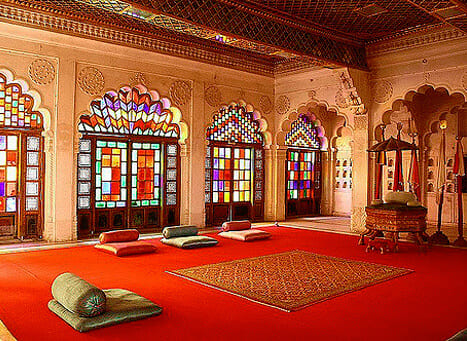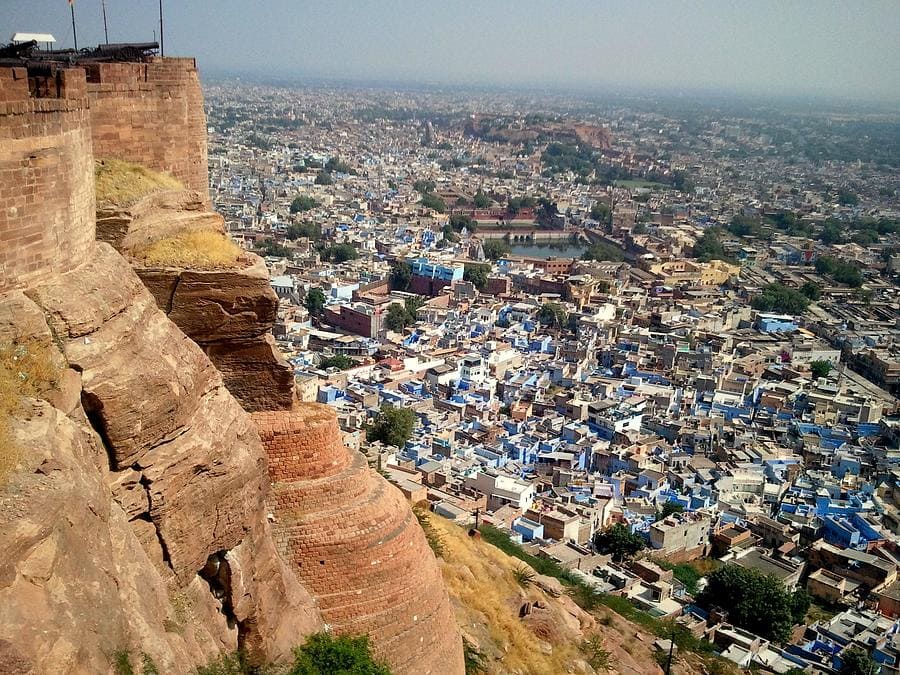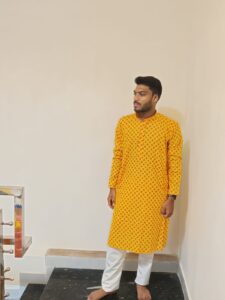Mehrangarh Fort Jodhpur, 400 feet above Jodhpur’s skyline, is one of India’s largest and most magnificent forts. Established in 1459 by Rao Jodha, this gigantic monument reflects Rajasthan’s glorious past in the form of grand palaces, exquisite carvings, and an interesting museum. Its imposing walls, breathtaking architecture, and panoramic views of the Blue City make it an absolute must-see. It is a timeless reflection of power, pride, and architectural excellence.
Mehrangarh Fort History
Mehrangarh Fort Jodhpur was constructed in 1459 by Rao Jodha, the king of Marwar and the founder of Jodhpur. Legend has it that when Rao Jodha decided to relocate his capital from Mandore to a more secure site, he picked the rocky hill known as Bhakurcheeria (the Mountain of Birds) to construct his fort.
To build the fort, they moved a sage named Cheeria Nathji, who lived on the hill. People believe that the sage cursed the land, proclaiming that it will always be drought-prone. To satisfy the curse, Rao Jodha built a modest temple and a dwelling for the sage within the fort grounds and buried a man named Rajaram Meghwal alive at the foundation site, which was a customary tradition at the time believed to bring good luck.
Over the decades, successive monarchs expanded this Fort. They built splendid palaces, courtyards, temples, and gateways such as Jai Pol and Fateh Pol to commemorate triumphs against neighboring kingdoms. Despite numerous wars and sieges, the fort remained unconquered due to its huge walls and strategic position.
| Details | Information |
| Name | Mehrangarh Fort |
| Location | Jodhpur, Rajasthan, India |
| Founded by | Rao Jodha |
| Year of Construction | 1459 AD |
| Elevation | 400 feet above the city |
| Famous For | Majestic architecture, museum, panoramic views, history |
| Opening Timings | 9:00 AM to 5:00 PM |
| Entry Fee | ₹200 (Indians), ₹600 (Foreigners) (approx) |
| Time to Explore | 2 to 3 hours |
| Best Time to Visit | October to March |
Mehrangarh Fort Architecture
The architecture of Mehrangarh Fort is a breathtaking combination of elegance and strength. With its massive red sandstone walls, the fort seems to emerge naturally from the rocky cliff. Inside the fort, you will see the palaces such as Sheesh Mahal, Phool Mahal, and Moti Mahal reveal ornate carvings, mirror work, and luxuriantly decorated interiors. The huge gates of the fort, such as Jai Pol and Loha Pol, tell the stories of its historical battles and victories. Delicate jharokhas (balconies), large courtyards, and curved passageways prove the genius of Rajput architecture. With panoramic views of the Blue City from its terrace, It is a marvel of art, majesty, and eternal royal pride. If you love to read about majestic forts you can also read about Amber Fort Jaipur, Kumbhalgarh Fort and City Palace Udaipur.
Mehrangarh Fort encompasses more than imposing walls and palaces; its magnificent gates, or poles, share tales of courage and triumph. As you walk in, you first see Jai Pol, or “Gate of Victory,” constructed by Maharaja Man Singh to commemorate a victory over the Jaipur armies.
Things to See at Mehrangarh Fort Jodhpur
Mehrangarh Fort Museum

Mehrangarh Fort Museum celebrates the rich cultural heritage and imperial legacy of the Marwar dynasty. The museum contains a majestic collection of artifacts such as royal palanquins, ornate elephant howdahs, ceremonial costumes, weapons and armor, miniature paintings, and decorative art. Every gallery testifies to the splendor of Rajasthan’s imperial past and the artistic merit of its populace.
- The Armoury Museum inside the Fort houses an excellent collection of Rajput weaponry that highlights the courage and martial tradition of Marwar’s soldiers. The displays include swords, daggers, spears, shields, and weapons, many of which once belonged to Jodhpur’s kings and nobles. Artisans ornately embellish some swords with gold, silver, and valuable stones, emphasizing both craftsmanship and royal status. The museum provides visitors with an insight into the military traditions and heroic spirit of Rajasthan’s warrior clans.
- The Palki Khana Museum at Jodhpur’s Mehrangarh Fort houses a stunning collection of royal palanquins (palkis) used by the Marwar royalty. These palanquins, made of wood or metal and ornamented with ivory, gold, or precious stones, were the royal family’s primary form of transportation during rituals and in daily life. The museum depicts the richness and artistry of Rajasthan’s royal past, emphasizing the exquisite decorations and cultural value of these ancient vehicles.
- The Daulat Khana, often known as the “Treasure Room,” is one of most spectacular galleries. It houses a large collection of royal artifacts, such as clothes, paintings, manuscripts, weapons, and personal possessions of the Rathore monarchs. This section provides a vivid peek into the luxurious lifestyle and artistic heritage of the Marwar dynasty. The curators exquisitely keep the antiques on display, demonstrating the refinement, taste, and grandeur of Jodhpur’s royal court over the years.
Some of its most striking displays are:
- Many swords and shields are beautifully adorned, with silver, gold, or jewels inlaid.
- Royal costumes and turban embellishments reflect the imperial trend of the time.
- Miniature paintings in the Marwar style reflect Hindu mythology, court life, and historical events.
- Rare manuscripts written in Sanskrit and Persian provide insight into the royals’ intellectual and spiritual lives.
Sheesh Mahal (Mirror Palace)

Sheesh Mahal, located within Mehrangarh Fort in Jodhpur, is a breathtaking example of Rajput mirror artistry and royal craftsmanship. Thousands of perfectly cut mirrors decorate the palace, reflecting light and creating a magnificent ambiance. Unlike normal mirror halls, it has exquisite murals of Hindu deities that combine spirituality and splendor. Sheesh Mahal, once a private chamber for the Maharajas, showcases Marwar’s rich artistic tradition and is now a popular attraction for travelers interested in Rajasthan’s royal legacy.
Phool Mahal
The Phool Mahal, also known as the “Flower Palace,” is Mehrangarh Fort’s most magnificent and ornate room. Maharaja Abhaya Singh built it in the 18th century to serve as the royals’ private pleasure room or hall of amusement. The area is lavishly embellished with gold filigree work, mirror embellishments, and bright paintings, particularly on the ceiling, which depicts elaborate floral patterns and royal portraits. Phool Mahal, symbolizing richness and refinement, exemplifies the Marwar dynasty’s creative magnificence.
Moti Mahal

Raja Sur Singh erected the Moti Mahal, also known as the “Pearl Palace,” in the 17th century. It is one of Mehrangarh Fort’s largest and oldest rooms. It served as the royal Durbar Hall, where the king met his ministers and held court. The hall has highly polished lime plaster walls that sparkle like pearls, stained glass windows, colorful niches, and a magnificent throne. The Moti Mahal symbolizes the Marwar monarchs’ regal might and artistic wealth.
Takhat Vilas
Takhat Vilas was the personal house of Maharaja Takhat Singh, Jodhpur’s last ruler, who lived in Mehrangarh Fort during the late nineteenth century. The space elegantly combines traditional Rajasthani and colonial features. Bright paintings, glass balls, and mirror work beautifully ornament the walls and ceiling, resulting in a vibrant and colorful ambiance. Takhat Vilas represents the artistic interests of the time and provides insight into the life of Jodhpur’s last fort-dwelling king.
Chamunda Devi Temple
Devotees adore the Chamunda Devi Temple, located on the southern side of Mehrangarh Fort, as a shrine to Goddess Chamunda, the furious aspect of Durga. Rao Jodha, the founder of Jodhpur, transported the statue to the fort around 1460, where she became the kuldevi (family deity) of the royal Rathore line. The temple is exceptionally vibrant during Navratri, attracting a large number of worshipers. With breathtaking views of the city, it is both a spiritual and scenic destination.
Janki Mahal
People think that queens and royal ladies used the Janki Mahal, which was part of the royal women’s quarters (zenana) at Mehrangarh Fort. It embodies the beauty and comfort of royal living, with delicate lattice windows (jharokhas), elaborate sculptures, and colorful interiors. Though smaller than the other palaces in the fort, Janki Mahal is historically significant and provides insight into the private lives of the Marwar royal women.
Cannon Display on the Terrace
At the top of the fort, especially around the ramparts and bastions, an exhibition of old cannons that previous defenders utilized to protect the fort during warfare allows tourists to witness. These giant iron cannons rest on stone pedestals and point towards the open plains, serving as silent guardians of Jodhpur’s past military history.
Some of the highlights are:
- The Kilkila Cannon, one of the biggest and strongest, which was feared in its time for its range and firepower.
- Other cannons were utilized in 18th- and 19th-century warfare, several still in superb condition.
Panoramic Views from Mehrangarh Fort Jodhpur

Mehrangarh Fort, which towers over Jodhpur at a height of roughly 400 feet, provides stunning views of the city below. Visitors can view the famed “Blue City”—a beautiful sea of indigo-colored buildings stretching over the landscape—from the fort’s many terraces and ramparts. These blue bungalows, historically painted to keep interiors cool and to identify Brahmin households, make a wonderful contrast against the yellow desert background.
On a clear day, you may view significant city landmarks such as
- Jaswant Thada (a marble cenotaph).
- The Umaid Bhawan Palace,
- The expansive Thar Desert horizon.
The vista is especially beautiful at sunrise and dusk, when the entire city sparkles in gold and blue, making it a popular destination for photographers and nature enthusiasts.
Mehrangarh Fort Timings
The Mehrangarh Fort Timings are from 9:00 A.M. to 5:00 P.M.
Mehrangarh Fort Ticket Price
- The Mehrangarh Fort ticket price for Indians is 200 Rs per person.
- The Mehrangarh Fort entry fee for Indian students is 100 Rs per person.
- The Mehrangarh Fort tickets for foreigners are 600 Rs per person.
- The Mehrangarh Fort Jodhpur ticket price for foreign students is 400 Rs per person.
Best Time to Visit Mehrangarh Fort Jodhpur
The best time to visit Mehrangarh Fort is from October to March, when the climate is pleasant and perfect for sightseeing. Early morning or late afternoon is ideal for escaping the scorching sun and enjoying lovely sunset views.
How to Reach Mehrangarh Fort Jodhpur
Mehrangarh Fort in Jodhpur is locally accessible easily by auto-rickshaws, cabs, e-rickshaws, and two-wheeler rentals or by personal vehicle. Tourists who are residing close to the old city can also walk to the fort.
Conclusion
Mehrangarh Fort is more than just a reminder of Jodhpur’s royal history; it is a living witness to Rajasthan’s rich heritage, architectural genius, and eternal magnificence. From its towering ramparts and panoramic views to its opulent palaces, sacred temples, and meticulously kept museums, the fort provides a rich and immersive experience of Rajput bravery, culture, and craftsmanship. Visiting Mehrangarh Fort is a unique experience that will leave every visitor with a greater understanding of India’s historical past and regal attitude.
Most Popular Question Asked by Traveller
It takes approximately 2 to 3 hours to cover Mehrangarh Fort, its palaces, museums, temples, and scenic spots. Provide additional time for photography, shopping, or relishing local snacks.
The most ideal time to visit Mehrangarh Fort is in the morning between 9:00 AM and 11:00 AM. The weather is pleasant, the light is ideal for photography, and crowds are less. Sunset is also lovely for panoramic views, but mornings are more serene to experience.
The ticket charge of Mehrangarh Fort Jodhpur is 200 Rs per person for Indians and 600 Rs per person for foreigners.
Mehrangarh Fort has been a favorite shooting destination, most prominently seen in The Dark Knight Rises (2012), where it depicted the legendary prison scene. Its grand architecture and dramatic landscapes have also featured in films such as The Fall, Awarapan, and Thugs of Hindostan, making it a favorite among filmmakers globally.



